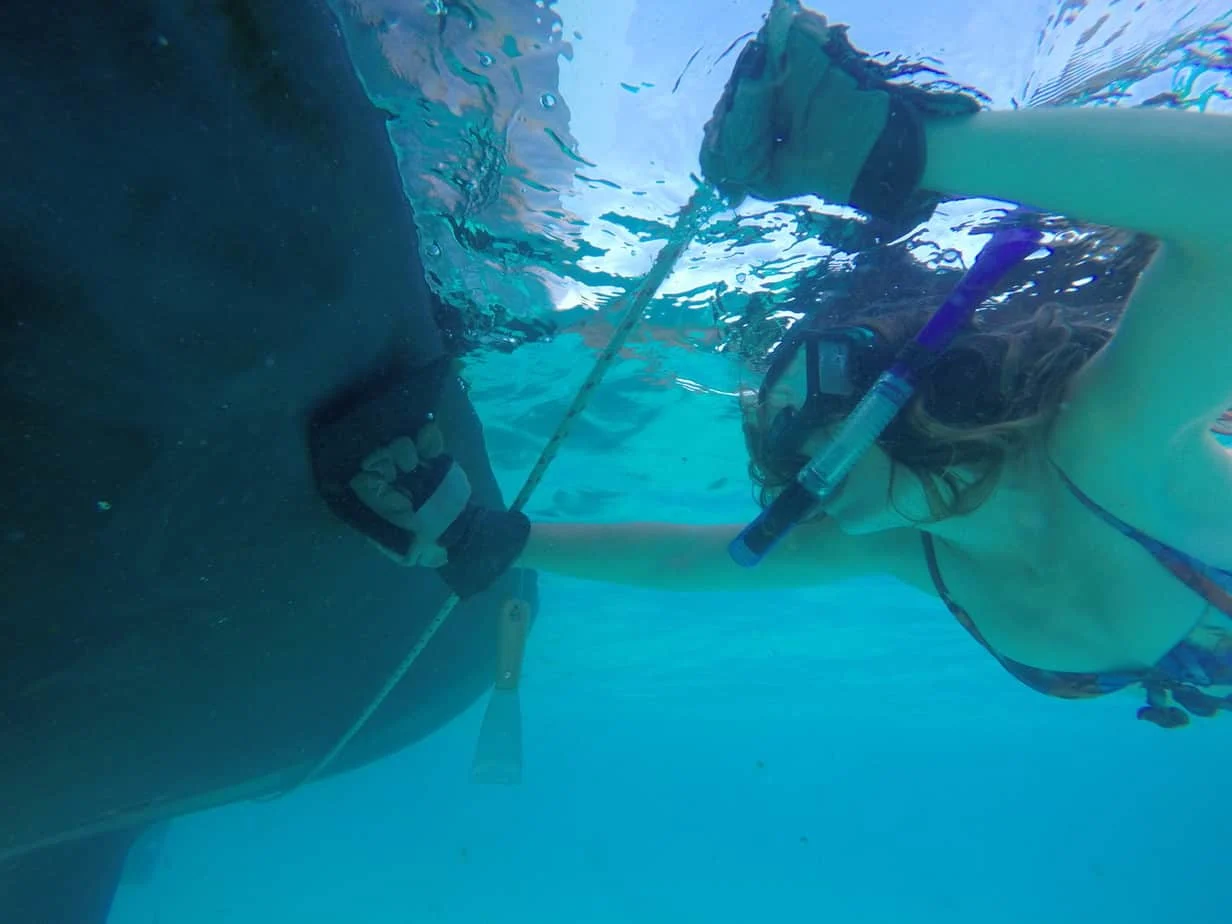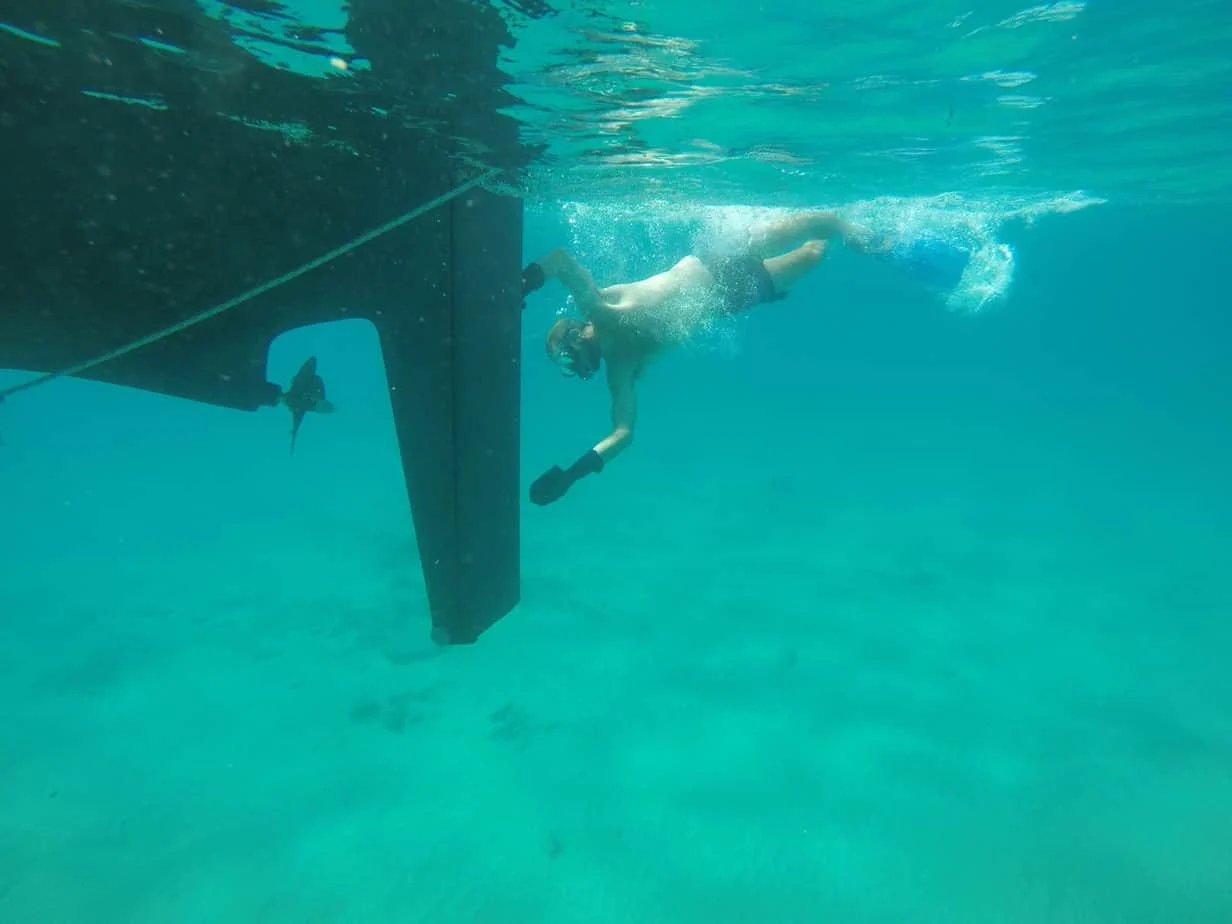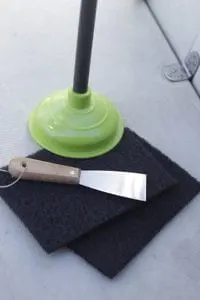We’d neglected the bottom of our boat for a month and the warm Mexican waters had transformed our sleek hull into a furry ecosystem teeming with life. My partner, Robin, had begun naming the fish living underneath MonArk, our Dufour 35. Presumably, they’d mistaken us for a benevolent barnacle-encrusted whale, or worse, a coral reef! It was time to clean the hull.
If you’re looking to clean the deck and hull (above the waterline), check out our post on these affordable homemade boat cleaners.
We’ve learned over time that cleaning the bottom makes a real difference when it comes to boat speed,boat handling, and ensuring the lasting value of our floating home. A fouled bottom causes drag, which results in increased fuel consumption when under power and lower speeds under power or sail. This matters as much to cruisers as it does to racers, particularly when the speed reduction is factored over hundreds or thousands of miles.
Believe it or not, heavy fouling can actually cause a boat to sit lower in the water. After we clean the bottom, we notice an improvement in our boat’s motion through the water and she is more responsive to the helm.
Another reason to keep the bottom clean is that growth left unchecked for long periods can damage the hull. The “glue” produced by fouling organisms clinging to the hull can damage both wood and fiberglass.
While scrubbing the bottom remains my least-favorite boat chore, I’ve discovered it’s possible to drastically reduce the effort it takes and the time we spend in the water by using the right tools and techniques. The first time we cleaned the bottom it took us close to 4 man hours; we’ve since got it down to less than 1 man hour. Today, it’s quite easy for us to maintain a clean bottom, and MonArk is no longer mistaken for a fish haven.
Types of fouling
Learning about the nature of the organisms that foul MonArk’s hull and the mechanisms of different antifouling paints has helped us refine our technique. Marine biologists estimate that there are more than 4,000 known fouling species! They can be broken down into three principal groups: animals, weeds,and slime. Animals include barnacles, mollusks, hydroids, and tube worms. They release millions of microscopic larvae into the water, all of which move around in currents, always looking to attach themselves to stationary objects. Weeds have varying characteristics. Many common seaweeds will simply fall off the boat as soon as it moves, while others, like brown weed, are more resilient and can withstand high boat speeds.
Slime is comprised of billions of single-cell algae that produce a syrupy medium in which to settle. Once established, they provide an ideal settling ground for more algae. Coatings can grow quite quickly and remain on the hull as it moves through the water. As we sail from place to place, we’ve noticed the stuff we find growing on MonArk’s hull varies considerably.
Differences in water quality and temperature result in different species of fouling. Factors like nearby population centers, inflows from rivers and streams, the speed of currents, and the amount of sunlight affect the types and degrees of fouling in a region.
Antifouling paints
Boat bottom paint (aka antifouling paint) is made from a combination of four primary ingredients: biocide (repels living organisms), resin (holds the product together), solvent (dictates application characteristics and cleanup methods), and pigment (determines color and viscosity). Whether an antifouling is soft (intended to ablate, erode, or slough off) or hard is determined by the type, combination, and quantity of resin used in the mix. When cleaning a boat’s underwater surfaces, it’s important to match the method to the type of antifouling on the hull. Ablative antifouling paint sloughs away over time, dissolving as water passes over the boat, taking any growth with it and revealing a fresh layer of biocide on the clean surface. Scrubbing ablative paint releases high concentrations of toxic material and drastically shortens the lifespan of the paint. It’s best to gently sweep away fouling with a soft cloth and avoid creating colored clouds of bottom paint. If the growth over an ablative paint does not release easily, it’s likely adhering directly to the bare hull, which means it’s time to haul out and repaint.
Hard paints dry to a hard, burnishable, and porous surface. They’re chemically designed to leach biocide on contact with water to prevent fouling growth. Hard paint may be scrubbed more aggressively than ablative paint, but it’s still important to use the least-abrasive material that is effective at removing the growth.Bear in mind that scrubbing antifouling releases toxic material and, for that reason, many locales do not allow in-the-water bottom cleaning.
Tools, gear, and tricks
Over time, we’ve learned that varying degrees of fouling and different areas of the boat require us to have a variety of tools at our disposal when cleaning MonArk’s bottom.
Snorkeling gear – In addition to a snorkel, mask, and fins, I sometimes wear a wetsuit and weight belt. Nothing is more exhausting than trying to keep myself submerged when scrubbing a few feet underwater, so attaining neutral buoyancy is helpful. Before going in, I always prime the inside of my mask with a dime-sized dollop of baby shampoo to prevent fogging.
Work gloves – I wear leather work gloves to keep me from bashing my knuckles or cutting myself on barnacles as I clean.
Plunger – Underwater, I’m weightless, so I use a toilet plunger to hold myself next to the hull while I scrub.
Hardwood scraper – We have a 2-foot length of 1 x 2-inch hardwood that we run against the hull to scrape and knock away the majority of growth quickly before moving on to . . .
Sponge, scrubbing pad, and brush – On light growth, we start with a sponge. If that’s ineffective, we’ll use a scrubbing pad or even a firm-bristled scrubbing brush. Whichever tool it is, I use one with the largest surface area practicable so I can cover more of the bottom in fewer strokes. We often use 3M Doodlebug Scrubbing Pads, which we can find at most chandleries.
Putty knife – I use a regular metal putty knife to scrape tough barnacles and hard growth from unprotected metal such as the prop, the shaft, and the screen on the cooling-water intake for the engine.
Long skinny screwdriver – Small clams and other hard growth often make their homes in the narrow through-hull passages. When I see a through-hull is obstructed, I carefully ream out the offending growth with a screwdriver.
Wire brush – Sacrificial anodes (zincs) are critical to protecting underwater metal from stray currents but are effective only when they’re clean. Growth will form on an anode that is not very active. The surface of an active anode accumulates a layer of oxide that looks like a white deposit. Anything on the surface of an anode, whether marine growth or oxide, will make it less effective and should be cleaned off. A wire brush is an ideal tool for this.
Line – To save energy and make it easier to apply pressure as we clean, Robin and I will sometimes use a line to grab onto and hold ourselves in place and against the boat. We run an old line, approximately a boat length and a half long, from the bow, down one side of the boat so it lies close to where the keel meets the hull, and make it fast at the stern on the other side of the boat.
Scuba or hookah gear – After I earned my scuba certification, cleaning the boat became physically easier. Not having to hold my breath or swim up for air conserves a great deal of energy. When I use the dive gear to clean the bottom, Robin will always spot me from the boat or join me in the water as a buddy diver for safety’s sake.
A cleaning routine
Because working in the water is tiring, we have developed a process for cleaning the bottom that is dependable and efficent.
Assess the growth – Before donning my snorkel and fins, I want to know what I’m dealing with. Is it merely a green film, or are there barnacles and weeds? In warmer waters, we often swim and snorkel around the boat at anchor, so I usually have a good idea of when it’s time to clean and what I’m facing.
Check the conditions – Before I commit to cleaning the bottom, I take note of currents, swell, traffic, and weather. I try to avoid hull cleaning in areas with a lot of traffic, as MonArk’s hull, suddenly rocking in a large ill-timed wake from a passing boat, can deliver a nasty knock to the head. Murky low-visibility water is another reason to postpone a cleaning. Visibility is restricted enough when I’m wearing a mask, but when the water is dark or dirty, cleaning the bottom is even more difficult. Even in clear water, the difference in underwater visibility between the sunny side of the boat and the shady side is significant. While I avoid working in strong currents, I find I can sometimes use a weak current to help me work my way down the length of the boat as I clean.
Lay out the tools – I never get in the water without first laying out — on the dock, swim platform, or dinghy — all the bottom-cleaning tools I might need where I can reach them from in the water. Where it makes sense, I tie string wristlets onto tools so I can loop them around my hands and not make unintended gifts to Poseidon.
Clean the waterline – Growth is often concentrated at the waterline, where it receives the most sunlight. Tackling this area from the dinghy can save me a good deal of energy especially when the water is cold. I simply pull myself in the dinghy around the boat, cleaning the waterline as I go.
Critical areas first – Often, I find I can spend only an hour in the water before I get too cold or too tired to continue, which makes it important to prioritize. Growth on the propeller and rudder has a greater impact on a boat’s speed and responsiveness than fouling on other submerged areas. I always start with our running gear.
From soft to abrasive – As I work my way around the rest of the boat, I start by running the piece of 1 x 2 hardwood lengthwise down the sides of the hull to quickly remove large areas of growth. I then move on to sweeping with the sponge and, if necessary, more aggressive tools like the pads, brush, and putty knife. By always using the least-aggressive means needed to remove growth, we’re preserving our paint and limiting the amount of biocide released into the sea.
Take a break – If growth is heavy, we’ll opt to break up the cleaning into multiple sessions. Between the cold, exertion, and swallowing a bit of seawater, it’s very easy to become exhausted or disoriented. It’s better to start with 15- to 30-minute sessions and not overdo it.
Don’t wait too long – The best way to keep bottom growth at bay is to clean frequently. Ideally, the growth would be no more than we can easily wipe away with a sponge. Frequency will differ by region (the warmer the climate, the faster stuff grows), paint condition and type (ablatives stay cleaner longer), and how the boat is used (boats that don’t move accumulate more growth).
Over time, we’ve been able to dramatically reduce the time and effort we spend cleaning the hull, and that leaves us with more opportunities to use our snorkeling gear to explore more scenic aquatic habitats!
This article was originally published in the Jul/Aug 2017 issue of Good Old Boat magazine. For more articles on seamanship and boat diy, pick up a subscription to Good Old Boat.
Fiona McGlynn is an award-winning boating writer who created Waterborne as a place to learn about living aboard and traveling the world by sailboat. She has written for boating magazines including BoatUS, SAIL, Cruising World, and Good Old Boat. She’s also a contributing editor at Good Old Boat and BoatUS Magazine. In 2017, Fiona and her husband completed a 3-year, 13,000-mile voyage from Vancouver to Mexico to Australia on their 35-foot sailboat.




Adi
Thursday 9th of August 2018
Have you seen the Remora Solo? Battery operated, light weight and compact. Brush creates suction against the hull, which makes cleaning mush easier.